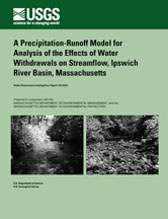
Water Resources-Investigations Report 00-4029
By Phillip J. Zarriello and Kernell G. Ries, III

 |
Water Resources-Investigations Report 00-4029 By Phillip J. Zarriello and Kernell G. Ries, III |
Water withdrawals from the 155-square-mile Ipswich River Basin in northeastern Massachusetts affect aquatic habitat, water quality, and recreational use of the river. To better understand the effects of these withdrawals on streamflow, particularly low flow, the Hydrological Simulation Program-FORTRAN (HSPF) was used to develop a watershed-scale precipitation-runoff model of the Ipswich River to simulate its hydrology and complex water-use patterns.
An analytical solution was used to compute time series of streamflow depletions resulting from ground-water withdrawals at wells. The flow depletions caused by pumping from the wells were summed along with any surface-water withdrawals to calculate the total withdrawal along a stream reach. The water withdrawals, records of precipitation, and streamflow records on the Ipswich River at South Middleton and at Ipswich for the period 1989–93 were used to calibrate the model. Model-fit analysis indicates that the simulated flows matched observed flows over a wide range of conditions; at a minimum, the coefficient of model-fit efficiency indicates that the model explained 79 percent of the variance in the observed daily flow.
Six alternative water-withdrawal and land-use scenarios were simulated with the model. Three scenarios were examined for the 1989–93 calibration period, and three scenarios were examined for the 1961–95 period to test alternative withdrawals and land use over a wider range of climatic conditions, and to compute 1-, 7-, and 30-day low-flow frequencies using a log-Pearson Type III analysis. Flow-duration curves computed from results of the 1989–93 simulations indicate that, at the South Middleton and Ipswich gaging stations, streamflows when no water withdrawals are being made are nearly identical to streamflows when no ground-water withdrawals are made. Streamflow under no water withdrawals at both stations are about an order of magnitude larger at the 99.8 percent exceedence probability than simulations with only ground-water withdrawals. Long-term simulations indicate that the differences between streamflow with no water withdrawals and average 1989–93 water withdrawals is similar to the difference between simulations for the same water-use conditions made for the 1989–93 period at both sites. The 7-day, 10-year low-flow (7Q10, a widely used regulatory statistic) at the South Middleton station was 4.1 cubic feet per second (ft3/s) with no water withdrawals and 1991 land use, 5.8 ft3/s no withdrawals and undeveloped land, and 0.54 ft3/s with average 1989–93 water withdrawals and 1991 land use. The 7Q10 at the Ipswich station was about 8.3 ft3/s for simulations with no water withdrawals for both the 1991 land use and the undeveloped land conditions, and 2.7 ft3/s for simulations with average 1989–93 water withdrawals and 1991 land use. Simulation results indicate that surface-water withdrawals have little effect on the duration and frequency of low flows, but the cumulative ground-water withdrawals substantially decrease low flows.
Abstract
Introduction
Purpose and Scope
Previous Investigations
Acknowledgments
Description of the Basin
Water Withdrawals
Precipitation-Runoff Model
Functional Description of the HSPF Model
Data Base
Streamflow Data
Meteorologic Data
Water-Withdrawal Data
Representation of the Basin
Hydrologic Response Unit
Impervious Areas (IMPLNDs)
Pervious Areas (PERLNDs)
Development of PERLND Types
Residential Areas on Public Water and Onsite Septic Systems
Stream Reaches
Hydraulic Characteristics (FTABLEs)
Wetlands
Water Withdrawals
Streamflow Depletion by Ground-Water Withdrawals
Water Withdrawals in Excess of Streamflow
Model Calibration
Mean Annual Discharge
Monthly Mean Discharge and Seasonal Water Budgets
Daily Flow
Flow Duration
Low Flows
Miscellaneous Discharge Measurements
Summary of the Differences Between Simulations with Reading and Centroid Precipitation Data
Sensitivity Analysis
Response of Pervious (PERLNDs) and Impervious (IMPLNDs) Land Segments
Parameter Values
Model Limitations
Application of the Model: Effects of Water Withdrawals on Streamflow
Calibration-Period Simulations
Long-term Simulations
Summary
References
Appendix A: Documentation of Computer Program STRMDEPL-A Program to Calculate Streamflow Depletion by Wells Using Analytical Solutions
Appendix B: Ipswich River Watershed Model (HSPF) User Control Input File for PERLND and IMPLND Blocks
AVAILABILITY
This report is presented in Portable Document Format (PDF). To view and print report you need to use Adobe Acrobat Reader, available as freeware.
Entire Report in PDF format (3.8 MB) - 107 pages
Title Pages in PDF format (32 KB) -3 pages
Contents in PDF format (136 KB) -4 pages
| AccessibilityFOIAPrivacyPolicies and Notices | |
 |
|